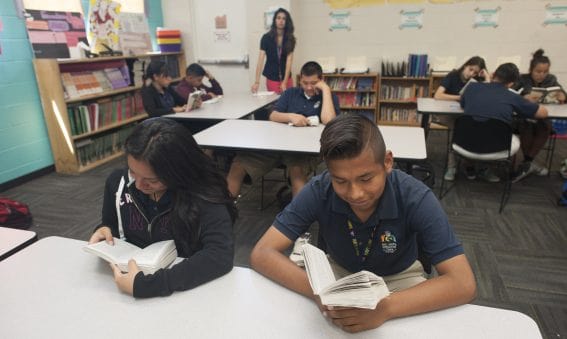By Kelly Powell and Ildi Laczko-Kerr
A new study[1] that examines student enrollment patterns in Maricopa County found that about 37 percent of district students participate in open enrollment. Given that Arizona school choice options also include public charter schools, the Center for Student Achievement expanded the findings[2] to include charter enrollment data for the attendance zones sampled in the study. This new analysis finds that nearly 50 percent of all students in these attendance zones do not attend their assigned district school. These combined data suggest that traditional school district attendance zones are becoming obsolete.
The chart below shows the percentage of students in the studied attendance zones whose families are choosing a school other than their assigned district school, broken out by district and charter attendance.
Percentage of Total Students NOT Attending Assigned District Schools
ABOUT THE DISTRICT STUDY
Though the study was limited[3] to nine school districts in Maricopa County, the authors’ spatial analysis painstakingly mapped student addresses and school boundaries for about one-third of district elementary school students in the county. The authors restricted their analysis to the elementary grades (K-8) in the 2016 school year. These grades collectively serve over 130,000 students. Students were considered “open enrolled” if they attended a district school outside of their attendance area, including within-district (students attending another school in the same district) and between-district (students attending school in another district) open enrollment.
The impact of within- and between-district open enrollment is striking. Not including charter student enrollment, results ranged from 15 percent to as much as 57 percent of the student population choosing to utilize open enrollment.
SCHOOL CHOICE IN MARICOPA COUNTY
When the Center for Student Achievement combined charter enrollment[4] for charters located within the study’s attendance zone, we found that 47 percent of students attended a school other than the one to which they are assigned based on home address. In one sampled attendance zone, as many as 81 percent of students participated in school choice.
Counts by School Choice Option in Nine Maricopa County Attendance Zones
THE NEW NORM
This analysis points to significant community demand for school choice, given the number of students opting to attend a district school other than the one to which they are assigned, coupled with the high percentage of students attending public charter schools.
Given this analysis, Arizona policymakers should take into account the widespread use and popularity of school choice at the local and state level when developing education policies and making budgetary decisions.
References and Footnotes
[1] “State of Open Enrollment in Maricopa County Oct 26th” manuscript by Matthew Hom and Patrick Cizek, October 26, 2017.
[2] The authors provided matched charter school K-8 enrollments within their sample of attendance zones.
[3] Besides limiting the number of participating Districts, the authors limited their analysis to the elementary grades. Their rationale to limit the analysis to K-8 was based in the fact that mobility patterns seemed to differ significantly in elementary and secondary levels, and without corresponding high school data for participating elementary districts, results would be difficult to interpret.
[4] An additional 25,503 students enrolled in charter schools located in the attendance zones of participating districts were included in the analysis. Enrollment counts were from the 2016 school year and were limited to kindergarten through grade 8 for “brick and mortar” schools. Online schools were not included in charter counts.


